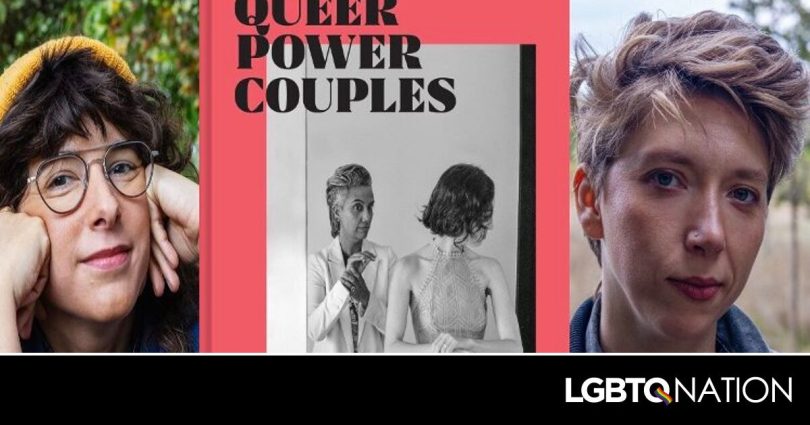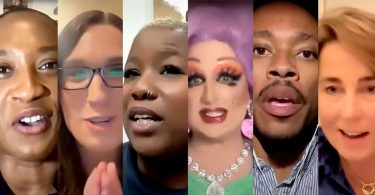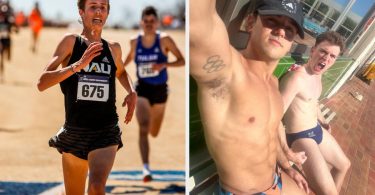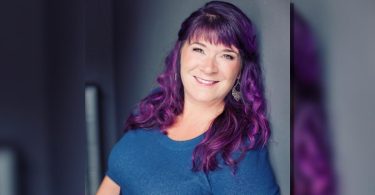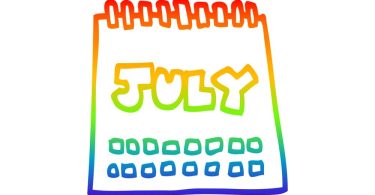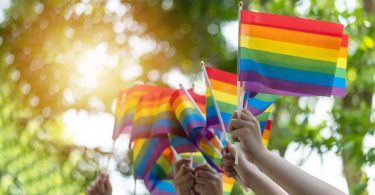What constitutes a queer power couple?
The world is full of them, after all. Queer people have long been considered overachievers, as well as influential figures in the workplace and in their personal communities. In short, they’re unstoppable when they come together, and if they’re lucky, they also become safe spaces for each other.
When journalist Hannah Murphy Winter and photographer Billie Winter (a queer power couple themselves, one might say) set out to create their new book, Queer Power Couples, they decided the criteria for inclusion was that the subjects must be out, coupled, and empowered to influence mainstream culture. The result is a photographic and journalistic showcase of fourteen such couples, including the likes of Roxane Gay and Debbie Millman, as well as Alan Wyffels and Mike Hadreas (AKA Perfume Genius). After spending about half a day with each of the couples in a space of their choosing, Hannah and Billie portrayed each love story here with care and curiosity, intertwining thoughtful interviews with tender, heartfelt photos of the partners (and often their dogs).
Never Miss a Beat
Subscribe to our newsletter to stay ahead of the latest LGBTQ+ political news and insights.
The book also signifies Hannah and Billie’s expansion of their own life together as they combine professional forces, making for a project that shines with a serenity and intimacy that feels almost at odds – in the most welcome way – with how you might typically expect to witness the featured pairings. Rarely do we see these hardworking, distinguished public figures as they’re shown here: relaxed, certain, in love, home.
LGBTQ Nation sat down with Hannah and Billie ahead of the book’s release to discuss love, intimacy, and what it’s like to be a queer power couple, themselves.
LGBTQ NATION: How did Queer Power Couples come to be?
HANNAH MURPHY WINTER: I was friends with an editor from Chronicle Books back in high school. During the COVID lockdown, I got an email from her saying, “Hey, I have this idea. Do you have time to hop on a call?” It was June of 2020, so I literally never had more time in my life. She was like, “I have this idea – there isn’t a photography book about queer power couples, and there should be… how would you feel about developing a book proposal, with you as the writer and Billie as the photographer?”
I thought, “What a good time to practice making a book proposal.” It did not occur to us at all that this would actually become a real book.
What does it mean to be a queer power couple?
Hannah: That was a lot of really fun conversations in our house.
Billie: I kind of came at it with what I wouldn’t want it to be. I definitely didn’t want it to just be a book of a bunch of rich, famous queer people. Once you get to a certain level of wealth, your queerness becomes way less of a defining factor of how you move through the world. You’re just a rich person at that point. So we got really deep into thinking about the criteria.
Hannah: We came down to… a queer power couple exists at an intersection of three things: they had to be out, they had to be coupled, and they had to be empowered to influence mainstream culture. Some of these are household names; some of them are not. From there, we were able to build a pitch around what’s unique about that intersection: that it hasn’t existed for very long, that maybe for only the last ten years has that actually been a well-populated intersection.
Billie: We wanted this book to exist within historical context. We didn’t want it to exist in a vacuum.
Billie, you write in your intro that “committing queerness to film has always been a radical act.” What kind of visual perspective of queer love do you hope this project leaves people with?
Billie: Intimacy was one of the primary goals of the photographic approach. My photographic strength is shooting candid, and I didn’t want to photograph people’s “personas.”
In our research, we looked back at the history of queer representation in photography, and some of the earliest explicitly queer portraiture that we found from the sixties and seventies was a huge influence on us, like JEB’s work, or Kay Tobin Lahusen’s work. That was kind of the first time that non-pornographic queer imagery was out there explicitly – these are gay couples, photographed in their homes, photographed in these really intimate moments. And it certainly was then, and it certainly is still now a radical act because… How vulnerable are you making yourself?
Hannah: To commit queerness to film is to inherently make yourself vulnerable and to put yourself on the front lines. You can’t code-switch a photograph. No matter what, once that’s on film, it’s there. It’s there to be consumed by whoever wants to consume it.
You are a queer power couple going into this project. What was that collaborative process like for both of you?
Hannah: We met at Rolling Stone, so we worked together for a few years before we became a couple. Because we had worked together first, that was always in the contours of our relationship. I will say that working on this project, we missed having a managing editor. But I think that this has always been a creative partnership, and when we were presented with an opportunity to work together again, it was such an easy yes.
Billie: I am obsessed with how Hannah’s mind works. She makes my work so much better and gets me to think about things with a depth that I otherwise would not have even attempted. Our taste is similar, but our approach to conceptualizing things is very different. We’ll catch the same subject at different angles.
(To Hannah) So because of that, you’re just such a dope creative partner for me.
Hannah: (to Billie) Likewise. I do feel like after working with you on this for three years, I can’t imagine going into any editorial project without your visual eye. Having your gut check is vital. So we might have to just be a package deal from now on.
Billie: Oh, darn.
I feel like I’m getting a small taste of what it must’ve been like for you guys to sit in on these couples.
Hannah: It was so much fun. One of my favorite questions was asking people what they loved about each other’s work. Because it was so fun to hear people fangirl or fanboy over their partner.
Billie: Every single time. No one disappointed.
I’d love to hear a standout moment from the book for each of you. For me, it’s the Perfume Genius dog.
Hannah: (to Billie) You show that to everyone.
Billie: Once I got that shot, I was like, “I don’t know how I’m gonna top this.” It’s this beautiful portrait of the two of them, and then you look down…
Alan Wyffels, Mike Hadreas, Wanda. Provided.
Hannah: One of the couples was unique for me, Candy Feit and Lydia Polgreen. I worked as a little baby news assistant at the New York Times shortly after college. My job was basically to do what anyone told me to do. I was in constant contact with all of our reporters all around the world, and one of those reporters was Lydia. I wasn’t out yet, and it was the first time that I worked with an identifiably queer woman in a position of power in my industry. So it was this really cool full-circle moment for me to then have her in the book.
Lydia Polgreen, Candy Feit. Provided.
Billie: One photograph in the book I’m really happy I got was Aisha and Sam deconstructing the fish together. It’s a very meditative thing for them, in terms of the prep for food service. And in my head, I was like, “I bet they do it in sync.” So when we went to the kitchen to photograph them, I was like, “Do you have fish to break down?” They were like, “Yeah, of course we do.” And it was exactly how I was hoping it was going to look. I think I probably took 500 images of them doing that, just rapid-fire shutter. It was really beautiful. Even the way they set up trays for each other.
Samantha Beaird, Aisha Ibrahim. Provided.
What did the process of creating this book teach you about love?
Billie: I already felt pretty smug about queer love. I think we are unplugged from the heteronormative matrix. These people found their best friend.
Hannah: It was really amazing to see all of these people who fell in love with someone that builds them up, and they fell in love with their biggest fan because they were also their biggest fan. All of them were so in love with each other and in love with each other’s work.
What I think was unique about a power couple is that you have to bring your work home. Loving each other’s work is part of loving them. That’s what made them more powerful together – because their partner saw all of them and loved all of them.
Billie: If I had to boil it down to one word… every couple in this book just oozes respect for one another.
Hannah: There’s this element of visibility, too. I think everyone in this book has a relationship to being visible, and chooses to love really loudly still. You feel the way that their heels are dug into this, their love for their partner and their love for themselves in that. There’s this element of self-love that I think is important: choosing to be visible is an act of self-love.
Queer Power Couples is available everywhere May 7, 2024.

